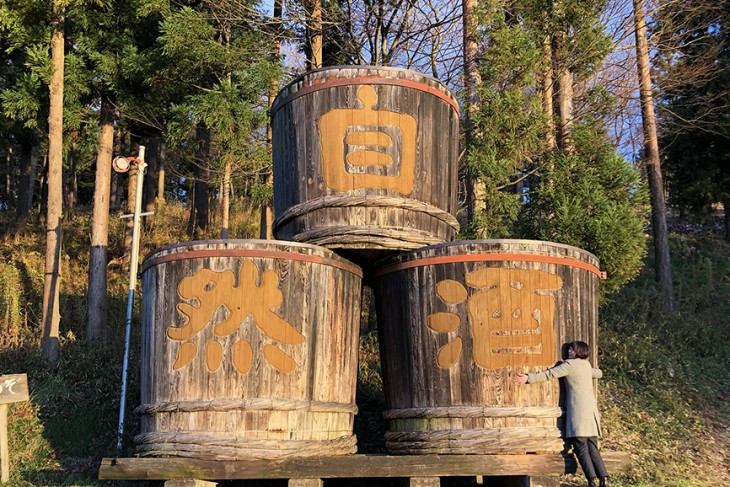
Niida Honke Sake Brewery
Founded in 1711, Niida Honke has seen eighteen generations of master brewers, each bringing their own personality and subtle changes to the company and its sake. The current head brewer is Yasuhiko Niida, an incredibly nice person with an awe-inspiring passion for making Sake.
Under Mr. Niida’s supervision, Niida Honke has seen many changes. In 2011 the brewery celebrated its 300th anniversary and the achievement of using 100% natural rice in its brewing process. Unfortunately, this was the same year as the Great East Japan Earthquake and the following nuclear disaster. Despite the difficulties, Niida Honke worked hard to return the health of the rice fields.
After the fields were cleaned and returned to their healthy status, a decision was made to move the company into a more sustainable and natural direction with the goal of creating its sake with 100% natural and organic ingredients. They currently grow much of the rice used to create their sake in the fields that surround the brewery. Working with local farmers to create healthy, high-quality rice that is grown without the use of pesticides or harmful chemicals.
In the future, Niida Honke aims to brew all of its sake in natural wooden tanks, switch entirely to solar power, and grow 100% of its own rice. For each bottle that you buy, Niida Honke takes one step closer to these goals.
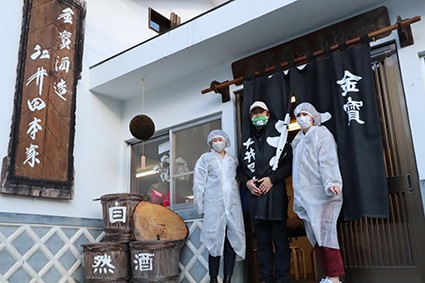
Growing the perfect crop (without the use of pesticides!)
Walking around the rice fields here is a unique experience and definitely worthwhile when visiting the brewery, no matter the season. Niida Honke pays close attention to the quality of rice that they use, they only use 100% naturally or organically grown rice, with no harmful pesticides or additives. In the same way that wineries pay attention to the quality of their grapes, and often grow them in their own vineyards, Niida Honke is looking to follow this same model but with rice. By paying close attention to the quality of the rice that they use, they are able to create more delicious sake. In the same way that walking through a vineyard adds depth to your wine drinking experience, drinking sake is made even more special by the sight of the rice fields. As the seasons change so do the rice fields.
In spring when the rice is planted the fields are flooded with clean mountain spring water sourced from the mountains near the village. The fields become enormous reflective pools that mirror the beautiful blue skies, the mountains, and even cherry blossom trees. In the summer, when the rice has grown tall and the fields turn a lush green. When the wind blows the stalks of rice shift like the fur of a magnificent beast. If you take a walk through the fields, you are sure to see some jumping frogs playing in the rice paddies. These frogs protect the rice fields from pests, so to honor their hard work Niida Honke uses frog characters on many of their labels and signs. As autumn approaches, the surrounding mountains are warmed by the autumn leaves. The lush green fields turn to golden brown and finally the harvest can commence.
My visit was in winter, so the huge fields lay barren for the season, waiting for the next year’s crops. In just a few weeks the rice fields will fill with snow. While the fields lay quiet for the season, the brewery works at full speed. Winter is the season when sake brewing takes place.
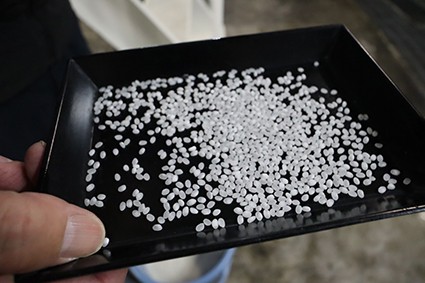
Polishing the rice
Once the rice has been harvested, it is polished (polishing is also known as milling) in a process that cuts through the outer layers of each tiny rice grain to reveal the pure white starchy inside. When using lower quality rice, more of the rice has to be polished, sometimes 50% must be chiseled away in order to make high-quality sake! This means that only 50% or less of the rice actually gets used to make sake. At Niida Honke, however, the quality of the rice is so high that it only needs to be polished by 73% to reach the level that is necessary to create delicious sake.
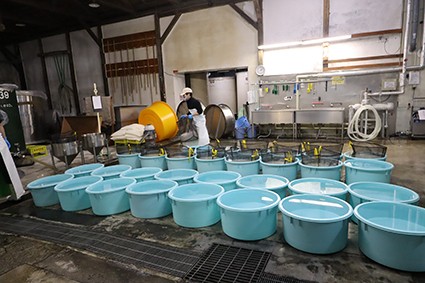
Preparing the rice
After the rice is polished, it is then washed, soaked, and rinsed to prepare it for steaming. Rice is spread out and steamed from below. From the moment that moisture meets the rice, each step is carefully timed to create the perfect product.
When the steaming process is complete, the rice must be quickly cooled. The outside of the rice should become cool and dry on the outside while the inside remains moist.
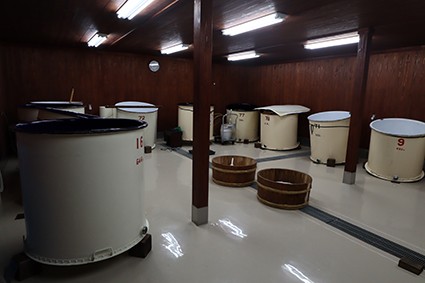
Making “koji rice”
Koji is a type of mold that is used to change the starch of the rice into sugar that the yeast will later feed on to make alcohol. This is a very important step in the process of sake brewing.
The freshly steamed and cooled rice is sprinkled with kojikin (koji mold spores) in a very warm room and left alone for about four days. During this time, the koji will make its way inside the rice grains. Since the center of the rice is still moist from the rapid cooling process, the koji is provided with a perfect environment to grow.
Inside this room, the air smells very sweet as the koji turns the starch into sugar!
Koji rice, yeast, and water are then combined in a room known as the “Motoba”. Here the air is cool but still smells very sweet. The combined mixture creates a small batch of sake that is known as a yeast starter, it has a very high yeast content. This is vital in the brewing process.
Brewing
Finally, the yeast starter, rice, water, and koji rice are all combined into a large brewing tank and left to ferment. This is known as the main mash, the combination of all of the ingredients. Sometimes piano music is played live on a grand piano on the floor above the brewing room, the music is thought to help the sake become more delicious.
Currently, the large tanks are mostly made from metal, but there are a few wooden tanks that make smaller batches. In the future, Niida Honke hopes to brew all of its sake in the traditional way, in large wooden tanks.
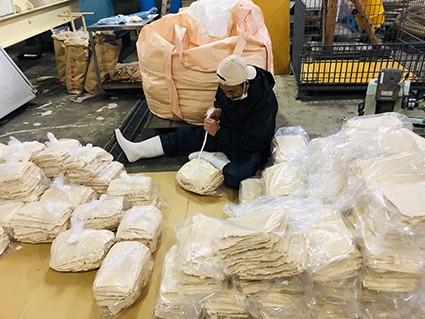
Pressing
Niida Honke uses the traditional method of separating the sake from the solids that are used during the brewing process. This method is called “Fukuro-Zuri,” literally “Hanging Bag.” As the name suggests, the combined ingredients are poured into bags that are tied to wooden poles. The bags allow the liquid sake to escape, trapping the excess materials in the bags.
The excess materials are pressed into thin sheets that are used to make other products such as the sweet non-alcoholic drink, “amazake,” various sweets, and more!
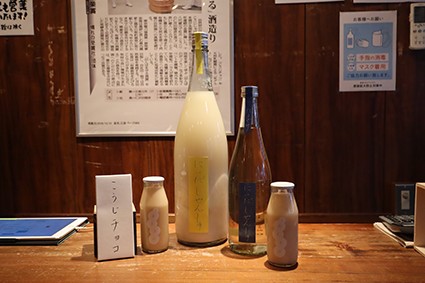
The final product:
Finally, sake is ready to be enjoyed! Sake can be enjoyed hot or cold and pairs well with many types of food so be sure to give it a try.


